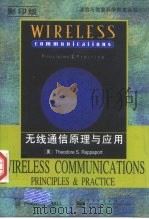《无线通信原理与应用 英文版》
| 作者 | (美)(T.S.拉帕波特)Theodore S.Rappap 编者 |
|---|---|
| 出版 | 北京:电子工业出版社 |
| 参考页数 | 641 |
| 出版时间 | 1998(求助前请核对) 目录预览 |
| ISBN号 | 7505348868 — 求助条款 |
| PDF编号 | 87495478(仅供预览,未存储实际文件) |
| 求助格式 | 扫描PDF(若分多册发行,每次仅能受理1册) |

1 Introduction to Wireless Communication Systems1
1.1 Evolution of Mobile Radio Communications1
1.2 Mobile Radiotelephone in the U.S4
1.3 Mobile Badio Systems Around the World6
1.4 Examples of Mobile Radio Systems9
1.4.1 Paging Systems11
1.4.2 Cordless Telephone Systems13
1.4.3 Cellular Telephone Systems14
1.4.4 Comparison of Common Mobile Radio Systems17
1.5 Trends in Cellular Radio and Personal Communications20
1.6 Problems22
2 The Cellular Concept-System Design Fundamentals25
2.1 Introduction25
2.2 Frequency Reuse26
2.3 Channel Assignment Strategies30
2.4 Handoff Strategies31
2.4.1 Prioritizing Handoffs34
2.4.2 Practical Handoff Considerations34
2.5 Interference and System Capacity37
2.5.1 Co-channel Interference and System Capacity37
2.5.2 Adjacent Channel Interference41
2.5.3 Power Control for Reducing Interference43
2.6 Trunking and Grade of Service44
2.7 Improving Capacity in Cellular Systems54
2.7.1 Cell Splitting54
2.7.2 Sectoring57
2.7.3 A Novel Microcell Zone Concept61
2.8 Summary63
2.9 Problems63
3 Mobile Radio Propagation:Large-Scale Path Loss69
3.1 Introduction to Radio Wave Propagation69
3.2 Free Space Propagation Model70
3.3 Relating Power to Electric Field74
3.4 The Three Basic Propagation Mechanisms78
3.5 Reflection78
3.5.1 Reflection from Dielectrics79
3.5.2 Brewster Angle84
3.5.3 Reflection from Perfect Conductors85
3.6 Ground Reflection(2-ray)Model85
3.7 Diffraction90
3.7.1 Fresnel Zone Geometry91
3.7.2 Knife-edge Diffraction Model94
3.7.3 Multiple Knife-edge Diffraction99
3.8 Scattering100
3.8.1 Radar Cross Section Model101
3.9 Practical Link Budget Design using Path Loss Models102
3.9.1 Log-distance Path Loss Model102
3.9.2 Log-normal Shadowing104
3.9.3 Determination of Percentage of Coverage Area106
3.10 Outdoor Propagation Models110
3.10.1 Longley-Rice Model110
3.10.2 Durkin s Model-A Case Study111
3.10.3 Okumura Model116
3.10.4 Hata Model119
3.10.5 PCS Extension to Hata Model120
3.10.6 Walfisch and Bertoni Model120
3.10.7 Wideband PCS Microcell Model121
3.11 Indoor Propagation Models123
3.11.1 Partition Losses(same floor)123
3.11.2 Partition Losses between Floors126
3.11.3 Log-distance Path Loss Model126
3.11.4 Ericsson Multiple Breakpoint Model128
3.11.5 Attenuation Factor Model128
3.12 Signal Penetration into Buildings131
3.13 Ray Tracing and Site Specific Modeling132
3.14 Problems133
4 Mobile Radio Propagation:Small-Scale Fading and Multipath139
4.1 Small-Scale Multipath Propagation139
4.1.1 Factors Influencing Small-Scale Fading140
4.1.2 Doppler Shift141
4.2 Impulse Response Model of a Multipath Channel143
4.2.1 Relationship Between Bandwidth and Received Power147
4.3 Small-Scale Multipath Measurements153
4.3.1 Direct RF Pulse System154
4.3.2 Spread Spectrum Sliding Correlator Channel Sounding155
4.3.3 Frequency Domain Channel Sounding158
4.4 Parameters of Mobile Multipath Channels159
4.4.1 Time Dispersion Parameters160
4.4.2 Coherence Bandwidth163
4.4.3 Doppler Spread and Coherence Time165
4.5 Types of Small-Scale Fading167
4.5.1 Fading Effects Due to Multipath Time Delay Spread168
4.5.2 Fading Effects Due to Doppler Spread170
4.6 Rayleigh and Ricean Distributions172
4.6.1 Rayleigh Fading Distribution172
4.6.2 Ricean Fading Distribution174
4.7 Statistical Models for Multipath Fading Channels176
4.7.1 Clarke s Model for Flat Fading177
4.7.2 Simulation of Clarke and Gans Fading Model181
4.7.3 Level Crossing and Fading Statistics185
4.7.4 Two-ray Rayleigh Fading Model188
4.7.5 Saleh and Valenzuela Indoor Statistical Model188
4.7.6 SIRCIM and SMRCIM Indoor and Outdoor Statistical Models189
4.8 Problems192
5 Modulation TEchniques for Mobile Radio197
5.1 Frequency Modulation vs.Amplitude Modulation198
5.2 Amplitude Modulation199
5.2.1 Single Sideband AM202
5.2.2 Pilot Tone SSB203
5.2.3 Demodulation of AM signals206
5.3 Angle Modulation206
5.3.1 Spectra and Bandwidth of FM Signals208
5.3.2 FM Modulation Methods209
5.3.3 FM Detection Techniques211
5.3.4 Tradeoff Between SNR and Bandwidth in an FM Signal219
5.4 Digital Modulation--an Overview220
5.4.1 Factors That Influence the Choice of Digital Modulation221
5.4.2 Bandwidth and Power Spectral Density of Digital Signals224
5.4.3 Line Coding225
5.5 Pulse Shaping Techniques225
5.5.1 Nyquist Criterion for ISI Cancellation227
5.5.2 Raised Cosine Rolloff Filter229
5.5.3 Gausssian Pulse-shaping Filter233
5.6 Geometric Representation of Modulation Signals234
5.7 Linear Modulation Techniques238
5.7.1 Binary Phase Shift Keying(BPSK)238
5.7.2 Differential Phase Shift Keying(DPSK)242
5.7.3 Quadrature Phase Shift Keying(QPSK)243
5.7.4 QPSK Transmission and Detection Techniques246
5.7.5 Offset QPSK247
5.7.6 π/4QPSK249
5.7.7 π/4 QPSK Transmission Techniques249
5.7.8 π/4 QPSK Detection Techniques252
5.8 Constant Envelope Modulation254
5.8.1 Binary Frequency Shift Keying256
5.8.2 Minimum Shift Keying(MSK)259
5.8.3 Gaussian Minimum Shift Keying(GMSK)261
5.9 Combined Linear and Constant Envelope Modulation Techniques267
5.9.1 M-ary Phase Shift Keying(MPSK)267
5.9.2 M-ary Quadrature Amphtude Modulation(QAM)270
5.9.3 M-ary Frequency Shift Keying(MFSK)272
5.10 Spread Spectrum Modulation Techniques274
5.10.1 Pseudo-noise(PN) Sequenes275
5.10.2 Direct Sequence Spread Spectrom(DS-SS)276
5.10.3 Frequency Hopped Spread Spectrum(FH-SS)278
5.10.4 Performance of Direct Sequence Spread Speetrum280
5.10.5 Performance of Frequency Hopping Spread Spectrum283
5.11 Modulation Performance in Fading and Mulitpath Channels284
5.11.1 Performance of Digital Modulation in Slow,Flat Fading Channels285
5.11.2 Digital Modulation in Frequency Selective Mobile Channels289
5.11.3 Performance of π/4 DQPSK in Fading and Interterence290
5.12 Problems294
6 Equalization,Diversity,and Channel Coding299
6.1 Introduction299
6.2 Fundamentals of Equalization300
6.3 A Generic Adaptive Equalizer303
6.4 Equalizers in a Communications Receiver307
6.5 Survey of Equalization Techniques308
6.6 Linear Equalizers310
6.7 Nonlinear Equalization312
6.7.1 Decision Feedback Equalization(DFE)313
6.7.2 Maximum Likelihood Sequence Estimation(MLSE)Equalizer315
6.8 Algorithms for Adaptive Equalization316
6.8.1 Zero Forcing Algorithm318
6.8.2 Least Mean Square Algorithm319
6.8.3 Recursive Least Squares Algorithm321
6.8.4 Summary of Algorithms323
6.9 Fractionally Spaced Equalizers323
6.10 Diversity Techniques325
6.10.1 Derivation of Selection Diversity Improvement326
6.10.2 Derivation of Maximal Ratio Combining Improvement328
6.10.3 Practical Space Diversity Considerations330
6.10.4 Polarization Diversity332
6.10.5 Frequency Diversity335
6.10.6 Time Diversity335
6.11 RAKE Receiver336
6.12 Interleaving338
6.13 Fundamentals of Channel Coding339
6.14 Block Cooes340
6.14.1 Examples of Block Codes344
6.14.2 Case Study of Reed-Solomon Codes346
6.15 Convolutional Codes352
6.15.1 Decoding of Convolutional Codes354
6.16 Coding Gain356
6.17 Trellis Coded Modulation356
6.18 Problems357
7 Speech Coding361
7.1 Introduction361
7.2 Characteristics of Speech Signals363
7.3 Quantization Techniques365
7.3.1 Uniform Quantization365
7.3.2 Nonuniform Quantization365
7.3.3 Adaptive Quantization368
7.3.4 Vector Quantization368
7.4 Adaptive Differential Pulse Code Modulation369
7.5 Frequency Domain Coding of Speech371
7.5.1 Sub-band Coding372
7.5.2 Adaptive Transform Coding375
7.6 Vocoders376
7.6.1 Channel Vocoders376
7.6.2 Formant Vocoders377
7.6.3 Cepstrum Vocoders377
7.6.4 Voice-Excited Vocoder378
7.7 Linear Predictive Coders378
7.7.1 LPC-Vocoders378
7.7.2 Multi-Pulse Excited LPC381
7.7.3 Code-Excited LPC382
7.7.4 Residual Excited LPC383
7.8 Choosing Speech Codecs for Mobile Communications384
7.9 The GSM COdec387
7.10 The USDC Codec389
7.11 Performance Evaluation of Speech Coders389
7.12 Problems392
8 Multiple Access Techniques for Wireless Communications395
8.1 Introduction395
8.1.1 Introduction to Multiple Access396
8.2 Frequency Division Multiple Access(FDMA)397
8.3 Time Division Multiple Access(TDMA)400
8.4 Spread Spectrum Multiple Access404
8.4.1 Frequency Hopped Multiple Access(FHMA)404
8.4.2 Code Division Multiple Access(CDMA)405
8.4.3 Hybrid Spread Spectrum Techniques407
8.5 Space Division Multiple Access(SDMA)409
8.6 Packet Radio410
8.6.1 Packet Radio Protocols411
8.6.2 Carrier Sense Multiple Access(CSMA) Protocols415
8.6.3 Reservation Protocols416
8.6.4 Capture Effect in Packet Radio416
8.7 Capacity of Cellular Systems417
8.7.1 Capacity of Cellular CDMA422
8.7.2 Capacity of CDMA with Multiple Cells425
8.7.3 Capacity of Space Division Multiple Access431
8.8 Problems437
9 Wireless Networking439
9.1 Introduction to Wireless Networks439
9.2 Differences Between Wireless and Fixed Telephone Networks441
9.2.1 The Public Switched Telephone Network(PSTN)441
9.2.2 Limitations in Wireless Networking443
9.2.3 Merging Wireless Networks and the PSTN444
9.3 Development of Wireless Networks445
9.3.1 First Generation Wireless Networks445
9.3.2 Second Generation Wireless Networks448
9.3.3 Third Generation Wireless Networks449
9.4 Fixed Network Transmission Hierarchy449
9.5 Traffic Routing in Wireless Networks450
9.5.1 Circuit Switching452
9.5.2 Packet Switching452
9.5.3 The X.25 Protocol454
9.6 Wireless Data Services455
9.6.1 Cellular Digital Packet Data(CDPD)455
9.6.2 Advanced Radio Data Information Systems(ARDIS)457
9.6.3 RAM Mobile Data(RMD)457
9.7 Common Channel Signaling(CCS)458
9.7.1 The Distributed Central Switching Office for CCS459
9.8 Integrated Services Digital Network(ISDN)461
9.8.1 Broadband ISDN and ATM463
9.9 Signaling System No.7(SS7)463
9.9.1 Network Services Part(NSP)of SS7465
9.9.2 The SS7 User Part466
9.9.3 Signaling Traffic in SS7467
9.9.4 SS7 Services468
9.9.5 Performance of SS7469
9.10 An example of SS7-Global Cellular Network Interoperability469
9.11 Personal Communication Services/Networks(PCS/PCN)472
9.11.1 Packet vs.Circuit switching for PCN472
9.11.2 Cellular Packet-Switched Architecture473
9.12 Protocols for Network Access477
9.12.1 Packet Reservation Multiple Access(PRMA)478
9.13 Network Databases479
9.13.1 Distributed Database for Mobility Management479
9.14 Universal Mobile Telecommunication System(UMTS)480
9.15 Summary481
10 Wireless Systems and Standards483
10.1 AMPS and ETACS483
10.1.1 AMPS and ETACS System Overview484
10.1.2 Call Handling in AMPS and ETACS485
10.1.3 AMPS and ETACS Air Interface487
10.1.4 N-AMPS491
10.2 United States Digital Cellular(IS-54)491
10.2.1 USDC Radio Interface493
10.2.2 United States Digital Cellular Derivatives(IS-94 and IS-136)500
10.3 Global System for Mobile(GSM)500
10.3.1 GSM Services and Features501
10.3.2 GSM System Architecture502
10.3.3 GSM Radio Subsystem505
10.3.4 GSM Channel Types507
10.3.5 Example of a GSM Call512
10.3.6 Frame Structure for GSM513
10.3.7 Signal Processing in GSM515
10.4 CDMA Digital Cellular Standard(IS-95)519
10.4.1 Frequency and Channel Specifications520
10.4.2 Forward CDMA Channel521
10.4.3 Reverse CDMA Channel527
10.4.4 IS-95 with 14.4 kbps Speech Coder[ANS95]533
10.5 CT2 Standard For Cordless Telephones533
10.5.1 CT2 Services and Features533
10.5.2 The CT2 Standard534
10.6 Digital European Cordless Telephone(DECT)535
10.6.1 Features and Characteristics535
10.6.2 DECT Architecture536
10.6.3 DECT Functional Concept537
10.6.4 DECT Radio Link538
10.7 PACS- Personal Access Communication Systems539
10.7.1 PACS System Architecture540
10.7.2 PACS Radio Interface541
10.8 Pacific Digital Cellular(PDC)543
10.9 Personal Handyphone System(PHS)544
10.10 U.S.PCS and ISM Bands544
10.11 U.S.Wireless Cable Television547
10.12 Summary of Standards Throughout the World548
10.13 Problems551
APPENDICES555
A Trunking Theory555
A.1 Erlang B556
A.1.1 Derivation of Erlang B556
A.2 Erlang C561
A.2.1 Derivation of Erlang C561
B Noise Figure Calculations for Link Budgets565
C Gaussian Approximations for Spread Spectrum CDMA569
C.1 The Gaussian Approximation577
C.2 The Improved Gaussian Approximation(IGA)582
C.3 A Simplified Expression for the Improved Gaussian Approximation(SEIGA)585
D Q,erferfc Functions593
D.1 The Q-Function593
D.2 The erf and erfc functions595
E Mathematical Tables599
F Abbreviations and Acronyms607
G References617
Index635
1998《无线通信原理与应用 英文版》由于是年代较久的资料都绝版了,几乎不可能购买到实物。如果大家为了学习确实需要,可向博主求助其电子版PDF文件(由(美)(T.S.拉帕波特)Theodore S.Rappap 1998 北京:电子工业出版社 出版的版本) 。对合法合规的求助,我会当即受理并将下载地址发送给你。
高度相关资料
-

- 用户环路载波通信原理与应用
- 1983 北京:人民邮电出版社
-

- 无线电发信原理
- 1974
-

- 餐饮与娱乐服务
- 1995 天津:天津人民出版社
-

- 有源天线原理与应用
- 1991 西安:西安交通大学出版社
-

- 无线电收信原理
- 1973 北京:中国人民解放军战士出版社
-

- 无线电收发信原理
- 1988 北京:海洋出版社
-

- 通信线路原理
- 1988 北京:人民邮电出版社
-

- 无线通信原理与应用
- 1999 北京:电子工业出版社
-

- 移动通信原理与应用
- 1998 北京:高等教育出版社
-

- 无线接入技术原理与应用
- 1996 北京:人民邮电出版社
-

- 现代移动通信系统
- 1999 北京:人民邮电出版社
提示:百度云已更名为百度网盘(百度盘),天翼云盘、微盘下载地址……暂未提供。➥ PDF文字可复制化或转WORD



